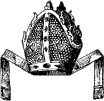Mitre
Mitre

Mitre, (fr. Mitre): one of the principal insignia of the episcopal office, although not belonging to it exclusively. There were three kinds of Mitres recognized by old writers--the precious, the 'aurifraged,' and the simple.
The privilege of wearing a mitre was first conceded to abbots and priors about the eleventh century. Soon afterwards it was decreed that mitred abbots exempt from episcopal jurisdiction should wear the second mitre mentioned above, the third being assigned to non-exempt abbots and priors. These rules do not appear to have ever been very strictly observed or enforced. It is the first which is always represented in heraldic drawing.
Though the use of the mitre as a part of the episcopal costume had, until quite recently , become obsolete in the Anglican Church, its prelates have continued to bear in above their arms. The mitres of the two archbishops, and the Bishop of Durham, are sometimes encircled with ducal coronets, which, however, is, at least in the two former cases, a practice of late origin, and without authority. The Bishop of Durham might(until lately) with propriety enjoy this mark of temporal dignity, as he was Count Palatine of Durham. His mitre in the sixteenth century was represented with a plume of ostrich feathers issuing from the sinister side and with the coronet.

The annexed figure of a mitre is taken from a roll of the peers of England, date 1515. The abbots' mitres drawn in that document are precisely similar in form, but differ in the colour of the enclosed triangular spaces. Earlier mitres were generally lower: in later times they have usually been represented much higher and more acutely pointed. It all cases they should be represented with the labels, or pendent ribbons at the sides of the mitre. Sometimes the term stringed is applied to these when denoting their tincture.
As charges, mitres occur in the insignia of several English sees and abbeys, and previous to the introduction of the practice of bishops impaling the insignia of their sees, they often differenced their paternal arms by the addition of mitres, keys, or other official insignia within the shield.
Gules, three mitres or--See of CHESTER.
Azure, three mitres or--See of NORWICH.
Azure, a saltire argent; in chief a mitre of the last garnished or--See of EDINBURGH.
Or, three torteaux, with a label of three points azure, charged with a like number of mitres gold[for difference]--William COURTENAY, Archbishop of Canterbury, 1381.
Checky or and azure, on a fesse gules, a mitre stringed argent; all within a bordure of the second--CLIFFORD, Bp. of Bath and Wells, 1401; Worcester, 1401; afterwards of London, 1407-21.
Argent, on a fesse azure, a mitre or; in chief three buck's heads caboshed gules; in base as many pheons sable--Thomas de BECKINGTON, Bishop of Bath and Wells, 1443.
Sable, three mitres or--Robert MASCALL, Bp. of Hereford, 1404-16.
Very few families bear mitres, but the family of BERKELEY bears for a crest(without any wreath) a mitre gules, labelled and garnished or, charged with a chevron between ten crosses patee six in chief and four in base--the family arms. Similar crests are used by some families of HARDING.
Azure, three mitres or--MYTERTON, Newcastle.
Or, on a bend between two cotises and as many garbs azure a mitre of the first--TYLSON.
Please Help!
DrawShield is a Free service supported by its users.

If you can, please help cover the cost of the server, or just buy the team a coffee to say thanks!
 Buy me a coffee
Buy me a coffee


